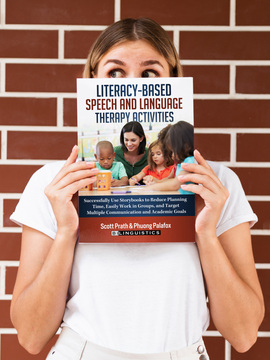Why is it REALLY good to bother with categorization when it comes to bilingual children? A broader measure of language knowledge not only enhances our understanding of a particular student’s language abilities; it is also more appropriate when evaluating diverse populations. Research points to significant variability in vocabulary size between students of different ethnic and social backgrounds, but these differences have not been accounted for in the norms of single-word picture vocabulary tests. Clinicians and researchers alike have questioned the construct validity, diagnostic accuracy, and appropriateness of using these measures with a variety of populations. Let’s move beyond simple measures of children’s word knowledge. We’re glad you’re joining us!
Why focus on categorization in speech therapy?
Let’s start with category generation ability in monolingual children:

Children have fascinating minds, whether they’re monolingual, bilingual, or multilingual! Studies of monolingual English-speaking and monolingual Korean-speaking kindergarten and second-grade students revealed interesting results. Researchers found that younger children organized their categories in a slot-filler, or specific way (e.g., foods for breakfast), whereas second graders produced more items in a taxonomic, or open-ended way (e.g., foods). These studies provided the first solid empirical evidence that older monolingual children integrate different event contexts into a larger structure. Children’s minds aren’t just sponges—they’re intricate and sophisticated sponges! And, as we all know, they are also highly influenced by experiences. Kindergarteners with preschool experience were able to produce more category items and appeared to have those items better organized than those without prior school experience.
And now for an overview of categorization in bilingual children:
We know that children begin to organize taxonomically, or more generally, as they gain experience with a variety of event contexts. Young typically developing bilingual children exhibit stronger categorization skills earlier than typically developing monolingual children. Researchers speculate that bilingual children might generate more items in the taxonomic condition sooner than monolinguals because their two languages have provided them with more experience across cultural-linguistic contexts. Similarly, since bilinguals have more lexical items to organize, they may have had more “practice,” and consequently may exhibit taxonomic organization sooner if the two systems are merged. This suggests that bilingualism can influence the number of words that a child can generate when asked to talk about a subject. (Bilingualism is so cool!) Because the category generation task has been found to detect a shift in how children organize vocabulary items across age, it has the potential to serve as a valid and reliable measure of lexical ability in children. (Our field is so exciting, isn’t it?!)
But why is it that cultural and linguistic variables affect the categorization ability of bilinguals?
You’re asking the right questions! Well, different theories abound. One explanation involves input. Based on work with Dutch monolinguals and bilinguals, one researcher highlighted the role of frequency of input in vocabulary acquisition and suggested that differences in the frequency of majority language contacts may result in differences in word knowledge between monolinguals and bilinguals. We know that language develops through experience as children are faced with a social and cognitive need to communicate, so this makes a lot of sense! From this perspective, development involves learning linguistic forms to communicate meaning through interaction. Environmental variables, experience, and cultural influences play defining roles. In other words, learning two languages involves different cultural and linguistic experiences. Because bilinguals and monolinguals use their language(s) differently, the way they organize knowledge may differ.
So what’s the deal with category generation abilities in language-impaired bilingual children?
Here’s where things get a little tricky, since the existing literature on category generation tasks is largely limited to the performance of children with typical development. Still unknown is how language impairment might impact the quantity and quality of items generated on a category generation task. Based on what we know, it is likely that children with language impairment will develop taxonomic categories later than children with typical development. We can expect that, based on how monolingual children with language impairment exhibit errors on naming tasks, bilingual language-impaired children might respond with “I don’t know,” use circumlocutions, mislabel, provide definitions and functions of targets rather than labels, and use noises and gestures to describe targets.
How can we use this information to improve how we address categorization in speech therapy?
Regarding typical language development, we would expect monolingual and bilingual children to be similar in total numbers of category items generated. However, the bilingual child will provide some categories in one language and some categories in the other, depending on exposure to the language. For example, bilingual children may produce household categories in their native language, and colors in English as learned in the classroom. This is totally normal! Considering the well-established shortcomings of current vocabulary measures, the category generation task may lend itself to detecting differences in the depth, breadth, and organization of vocabulary in the presence of language impairment. We can provide valuable intervention for our students with language impairment by teaching strategies and giving them the practice they need for building their categorization abilities.





Great to read about categorization as a foundational skill. The “next level of language ability” includes the ability to determine main ideas and writing well-constructed stories and reports in school. Joan Sedita (The Key Comprehension Routine: Primary Grades) states “Categorizing is the most basic application of main idea skills.” It also facilitates studying through categorizing and storing information by main idea topics and subtopics. Too often, we SLP’s have stopped categorization skills at the word/category label level while teachers continue to attempt to teach primary students how to determine main ideas without adequate practice in categorization.
Carolyn,
Thank you so much for your comment! We especially appreciate your knowledge regarding the “next level of language ability”. Focusing on higher level thinking skills is pertinent, functional and impactful for our clients and students. Thanks, Carolyn.
Phuong